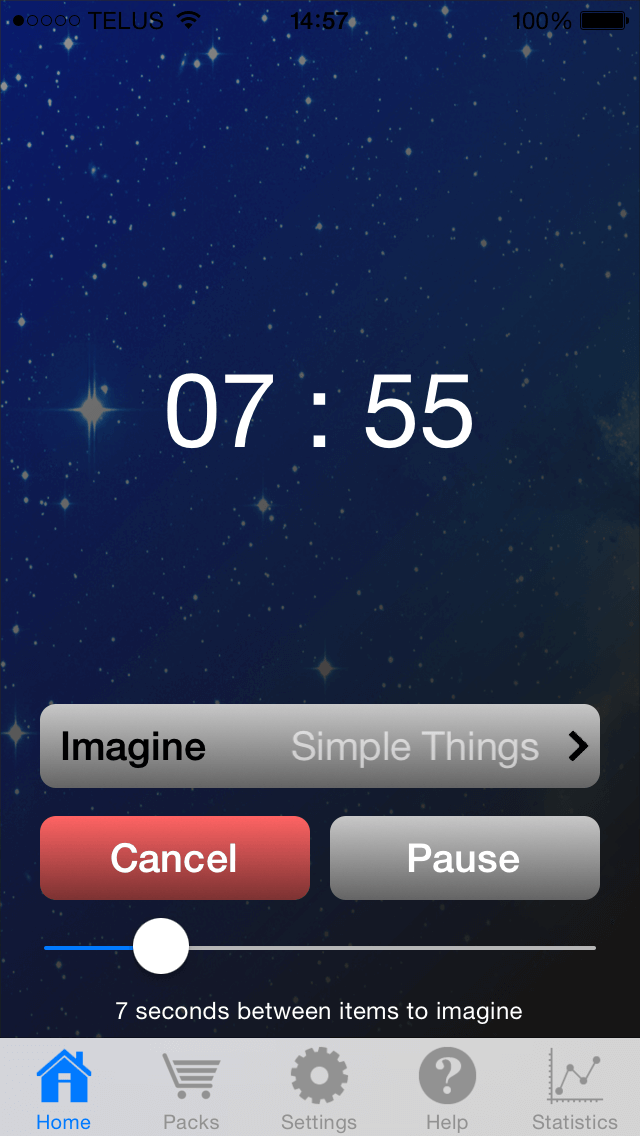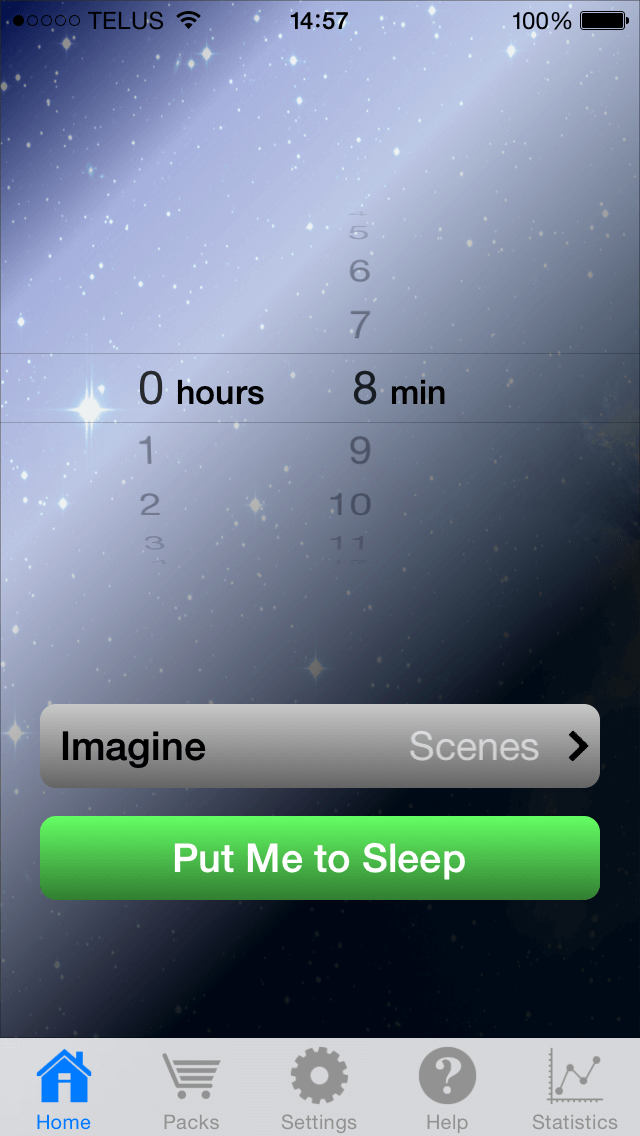Shuffle Your Thoughts to Sleep…
mySleepButton is an app designed to help you fall asleep. It’s based on our contribution to cognitive science. Just press the “Put Me to Sleep” button, close your eyes, and imagine the various things mySleepButton reads to you as you fall asleep.
Sleep-onset Reimagined
It’s much easier to fall asleep when:
- you keep your mind off the kind of thinking that keeps you awake,
- your mind wanders from one “random” image to another.
mySleepButton is designed to put your mind in this sleep-inducing state.
All you need to do is:
- press the “Put Me to Sleep” button, and
- imagine the diverse things mentioned by the app.
This will keep your mind off your concerns and into a state that is wonderfully conducive to sleep…
It’s that simple.

Let your Imagination Lull You to Sleep
Adults live in a very “left-brain” world dominated by language and thinking. Young children in contrast spend a lot of time imagining and playing. Of course, adults look at a lot of images — videos, TV, film, photos and logos. But they tend to do so passively, and usually with lots of chatter (whether it’s vocal or not).
Sleep researchers have found that as people fall asleep, they often experience visual images and “micro-dreams”. The diverse images people imagine may help them fall asleep.
In contrast, continuing to think in a verbal, analytic, problem-solving mode can delay sleep onset.
mySleepButton helps you replace your internal mental dialog with a dreamy parade of sundry images that might be more conducive to sleep.
Choose What You Imagine (mySleepButton Pack)
mySleepButton gives you the choice between several different kinds of things to imagine, each in its own mySleepButton Pack:
- Simple Things (single words or short phrases),
- Scenes (multi-word phrases, e.g., “Bird on a branch”), and
- Things to Draw.

Play to Sleep
Many busy people are not only sleep deprived, they’re play deprived. As Dr. Stuart Brown, author of the book, Play: How It Shapes the Brain, Opens the Imagination, and Invigorates the Soul, says:
a highly playful child or adult is not going to be depressed. It’s a signal of good emotional health. And conversely, the lack of play and the downer which that evokes in most of us is smoldering depression. […] the evidence is so solid that if you do incorporate healthy play into your life your performance is going to be better, your health is going to be better, your relationships are going to better.
Dr. Stuart Brown
mySleepButton is a playful app.
There is even a game-like way of using the principles leveraged by mySleepButton: Do-It-Yourself Cognitive Shuffle.
Be an Artist: Imagine Drawing to Sleep
Not only do people not play enough, or imagine enough, they don’t draw enough either. Well, who would have thought that a sleep app could also let you draw?
When you choose the “Things to Draw” mySleepButton pack, the app names things to imagine yourself drawing, one at a time. Fortunately, drawing in your head is a lot easier than drawing on paper. Just imagine yourself easily drawing the item!
Will imagining yourself drawing help you draw during the day? Many psychologists believe visualization does help performance. For example, as a way to practice, some professional hockey players imagine themselves scoring. Find out if it works for you!
Testimonials
We’ve received a lot of positive feedback about mySleepButton. For example…
- Marj “OMG – I was astonished. It worked” (May 1, 2017 testimonial) May 3, 2017All I can say is …. this is the answer to sleepless nights, when the hamster wheel is in overdrive. I feel like I haven’t slept for months, having a really tough time, waking up in the morning feeling exhausted. I heard a quick snip on CBC radio re: Serial Diverse Imaging, interest piqued for ...
- Brett Terpstra, Read and Trust Productivity Blogger, Podcaster, App Developer July 13, 2014The act of changing completely what you’re thinking about every 15 seconds or so disrupts your brain from being able to get onto what you were thinking about, to get onto those racing thoughts that keep you awake at night… You just start to drift off and fall asleep. I’ve found very ...
- Dr. Tomas Kuca, Anesthesiologist June 24, 2014“I’ve been trying out your app – It’s a fantastic concept and it’s definitely effective. ” Dr. Tomas Kuca, Anesthesiologist
- Ken MacAllister @kenmacallister May 24 June 20, 2014Trouble sleeping? The free, http://mysleepbutton.com app from @CogSciApps will knock you out without drugs. I tried it, and it really works.
- James Harcus (Port Coquitlam Firefighter) May 16, 2014I’ve been using the cognitive shuffle for over a year now. Every time I can’t get to sleep because I have had too much coffee or whatever, I just do the cognitive shuffle and it knocks me into sleep.
Show more testimonials
How Does mySleepButton Compare to Other Sleep Apps?
mySleepButton uses a radically different approach to induce sleep than the other apps on the market.
- mySleepButton is based on theories about sleep, moods, emotion, motivation, consciousness, AI and more.
- mySleepButton leverages the new cognitive shuffle / somnolent mentation framework proposed by CogSci Apps Corp. co-founder, Dr. Luc Beaudoin.
- mySleepButton is meant to improve upon the well-researched (monotonous) “imagery training” method.
- mySleepButton gets you to serially imagine diverse things.
- mySleepButton is extremely simple.
- mySleepButton is laser-focused on sleep onset; it does not require that you enter personal data or delve into psychological issues.
- mySleepButton has an option to imagine yourself drawing items, which can also induce sleep (and is fun!).
- mySleepButton even has a DIY variant.
- mySleepButton code is also used in a tool available only for sleep researchers, meaning that it contributes to scientific knowledge.
- mySleepButton is designed to help us continuously improve our understanding of sleep onset and to improve the app itself.
- We have a backlog of new CogSci Apps™ features and enhancements to mySleepButton in the works; they are gradually being introduced in product updates.
- mySleepButton deliberately involves a form of play; it’s fun!
mySleepButton is free to try on iOS, and less than $5 on Google Play (prices vary by jurisdiction). If you find it helpful, please consider purchasing one or more of the Full mySleepButton packs from the Packs tab. The packs give you more content to imagine. Developing a better cognitive sleep aid that does not involve medication has been a major objective of sleep research for a long time. Your purchase will help fund our Research & Development to make this app even better. Because mySleepButton is also part of a scientific project, you are also supporting the development of a scientific tool. Hence you are supporting sleep research and cognitive science. This inexpensive app has the potential to help millions of people. Please also consider letting others know about mySleepButton.
CogSci Apps™ software is designed to work with the human mind. Although mySleepButton is fun, we take cognitive science very seriously. Compare Luc Beaudoin’s book, Cognitive Productivity: The Art and Science of Using Knowledge to Become Profoundly Effective.
Somnolent Information-processing Theory of Sleep-onset
mySleepButton is based on a recent theory about how the human sleep onset control system.
Here are the basic concepts and postulates.
- “Insomnolent mentation” is mentation that interferes with falling asleep.
- “Counter-insomnolent mentation” is mentation that interferes with insomnolent mentation (e.g., typical meditation and progress relaxation). That is what a lot of psychological techniques involve. But this is not always sufficient to push you over the edge into sleep!
- “Pro-somnolent mentation” is thinking in a manner that signals to your brain that it is time to fall asleep.
- Whereas waking consciousness is characterized by a tendency to maintain a coherent awareness, while falling asleep thinking becomes less constrained by coherence, and the brain often produces micro-dreams, a cognitive shuffle.
- Information-processing and experience that the brain tends uniquely to produce during sleep-onset is pro-somnolent. That means that the sleep onset control system contains a positive feedback loop.
If this is true, then other things being equal, if you can engage in mentation that is both counter-insomnolent and pro-somnolent, you are more likely to fall asleep. That is what mySleepButton is meant to facilitate:
- Super-somnolent mentation = Counter-insomnolent + pro-somnolent mentation.
This theoretical framework is not meant to replace, but to augment, previous postulates about sleep-onset based on circadian and homeostatic sleep factors. The somnolent information-processing theory also contains other postulates that are meant to make sense of data about how “emotions” and motivation can affect sleep-onset latency.
The theory raises many exciting new empirical questions and possibilities that will need to be tested in and outside the lab. Some naturalistic studies have taken place on this theory, involving several Canadian universities. We have more planned. We hope this theory will spawn much more research.
Similarly, the theory is not meant to replace prior evidence-based recommendations, but to explain why they work when they do, and why they don’t when they don’t.
Meanwhile, the software is free to try, so you can find out for yourself if and when the techniques are helpful.
Find Out More
Check out our support pages for more information.
Sign-up to our newsletter. We only use it for major announcements, such as the upcoming availability of the Android version of mySleepButton.
There is more to the theory than described above. You can read about it here and in the documents linked from here.
Share
So, give mySleepButton a try. And let your family and friends know through Twitter, Facebook, email or other social media that they can shuffle their thoughts to sleep with mySleepButton.


